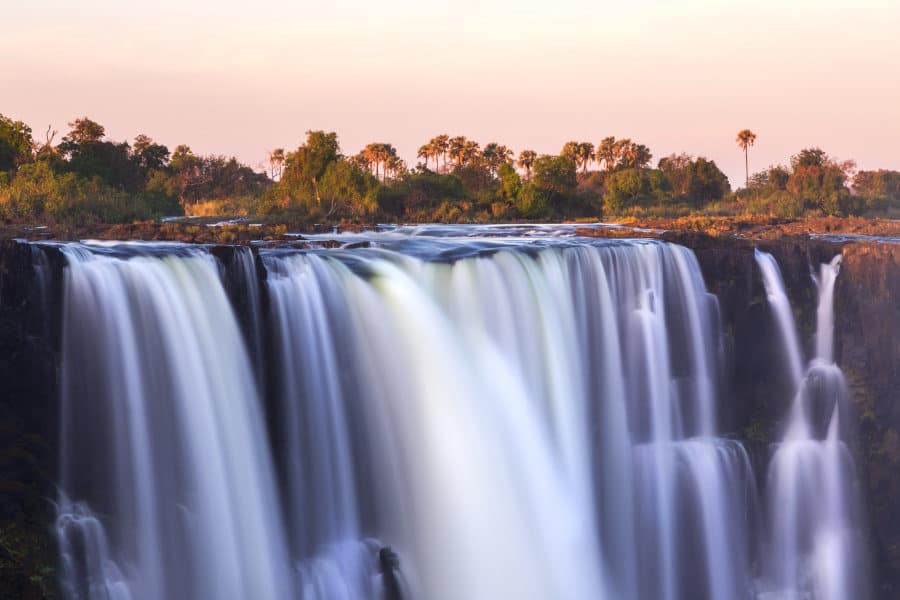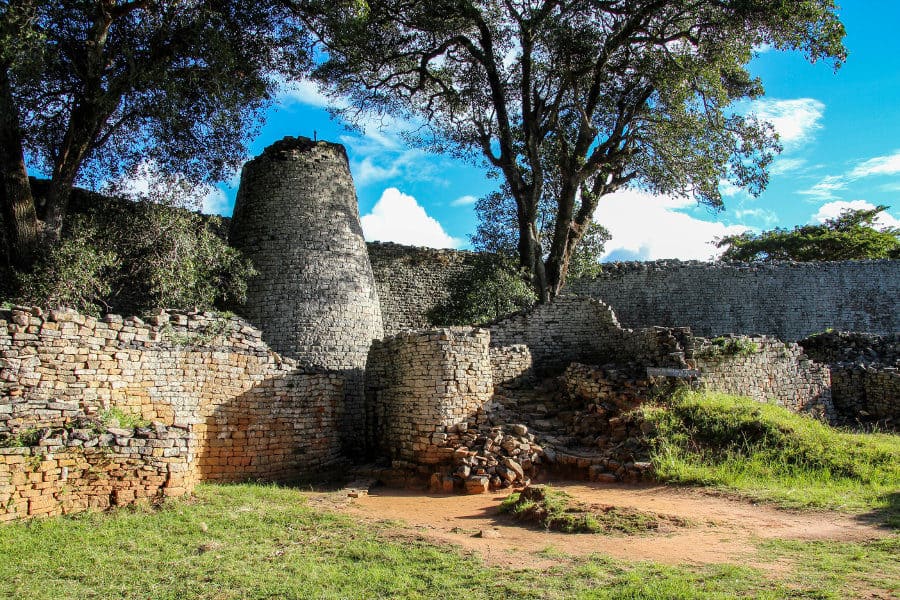Victoria Falls is the world’s greatest waterfall. But it’s much more than that. The surrounding area has also become Africa’s ultimate destination: wildlife, nature, culture, adventure and wilderness, all in one.
This part of Africa is the perfect place to relax if you’re on a long journey across the continent. It’s also a great choice when it’s your first time to Africa and you’re only staying for a week or two.
This is a destination that offers countless possibilities. So read on as this is the ultimate Victoria Falls guide, showing you the waterfall, different travel options, activities, day trips, when to go and much more.
Victoria Falls Location
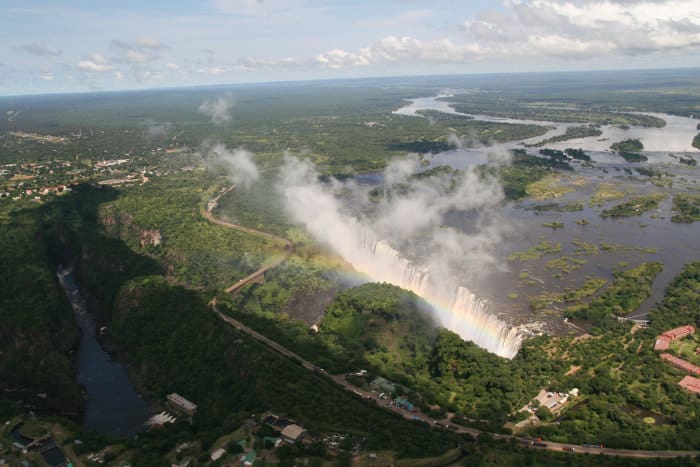
This new seven wonder of nature is situated along the Zambezi River, between Zambia and Zimbabwe. It’s roughly in the heart of Southern Africa, at a junction where four different countries meet.
Visit Victoria Falls and you must decide whether to stay on the Zambian or Zimbabwean side of the river. But it’s easy to cross the bridge, enter another country, and spend a day on the other side.
Wherever you stay it only takes an hour to drive west to Namibia and Botswana, so you can easily visit four different countries on a one-week location.
Victoria Falls? Livingstone? What is What?
Mosi-oa-Tunya, or Victoria Falls, is the name of the waterfall.
Victoria Falls is also the name of the town on the Zimbabwe side of the river. The town’s main road takes you straight to the falls.
Livingstone is the town on the Zambian side of the river. It’s actually eight kilometres from the falls but you can also stay in wilderness lodges along the river that are closer.
Originally, Livingstone was located right on the river. But there was too much malaria for the colonialists so they moved the town away from the water.
Get the Name Right – It’s Mosi-oa-Tunya

Okay, on most maps it still says Victoria Falls. But the locals knew about the waterfall long before any European. The first European to “discover” the falls was Dr David Livingstone, who named them in honour of his queen, Victoria.
You can read more about Livingstone’s discovery in this article.
Mosi-oa-Tunya is the name given to Victoria Falls by the Lozi people, who are indigenous to this corner of Africa.
What does Mosi-oa-Tunya mean?
“The Smoke That Thunders”, and that’s the best description you can give for the spectacle. It’s far more descriptive than naming it after a woman who had never even set eyes on the Zambezi River.
Go even further back in history and southern Tonga tribes such as the Batoka and Tokaleya called the falls Shungu na mutitima. This name also roughly translates as The Smoke That Thunders.
David Livingstone also recorded another local name – Chongwe. This means “The Place of The Rainbow” and is also very accurate, especially during the time of peak flow.
Victoria Falls Facts
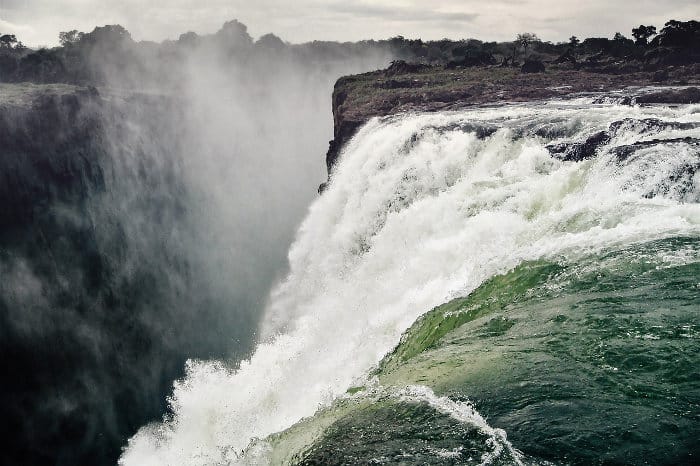
Mosi-oa-Tunya is neither the highest nor the widest waterfall in the world. But it is considered the largest, for two reasons.
It has the largest curtain of falling water. And during peak flow, more water falls over the edge here than at any other waterfall on the planet.
Height of the Falls
Victoria Falls is 108 metres at its highest point. However, the ledge is not straight so there are different heights as you look from Zimbabwe to Zambia
Width of the Falls
Victoria Falls are 1700 metres wide.
Volume of Water
This natural wonder changes dramatically with the seasons. Visit Victoria Falls in November and you may initially be disappointed. That’s the end of the long dry season in Southern Africa. The rivers are parched and the Zambezi is at its lowest.
At its lowest there are only 400,000 litres of water falling over the edge…every single second. Impressive. But not that impressive.
The rains come down from December to April. So it’s in April and May that you’ll witness the greatest volume of water – around 6.5 million litres of water flowing over the precipice, every second. That’s 390 million litres a minute, 23.6 billion litres an hour, and 566 billion litres in a day!
During the floods of 1958 they recorded 12.6 million litres per second, the highest flow ever recorded.
Average the volume of water over an entire year and Victoria Falls has a mean annual flow rate of 1.088 million litres of water per second.
Mosi-oa-Tunya is Actually Five Different Waterfalls in One
During peak flow it’s impossible to distinguish one from the next. They merge to become a single sheet of falling water.
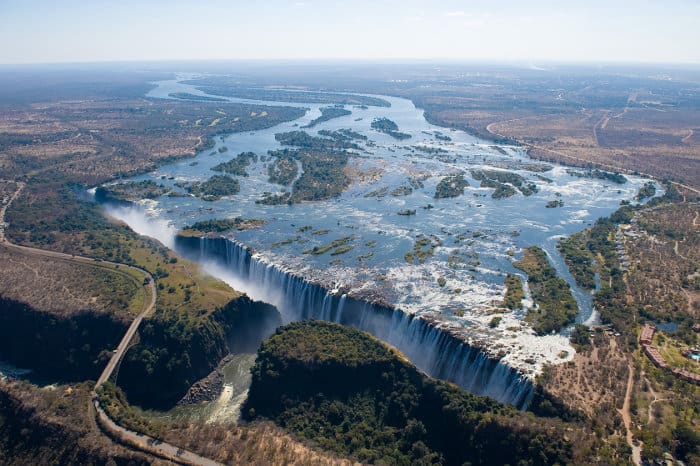
Visit during mid or low-water times and you can clearly see that this single waterfall is made up of five different pieces. When looking directly at the falls, here are the five cascades from left to right.

The Devil’s Cataract (Zimbabwe) – 70 metres
Gushing through a narrow channel into a whirlpool far down below, the Devil’s Cataract would be a major attraction anywhere else.
When visiting from Zimbabwe these are the first falls you will see and they are mightily impressive – until you witness what comes next!
Main Falls (Zimbabwe) – 93 metres
Majestic at any month of the year, the Main Falls is the greatest expression of Mosi-oa-Tunya. There’s so much water that much of it turns to mist before it even lands.
These falls growl at you, a rumbling baritone that can be heard from up to ten kilometres away. During peak flow you’ll get wet from the spray (or the smoke as it’s called), as it rises up then descends on the forest trail.
Although visible from Zambia the Main Falls are most impressive from Zimbabwe as you can stand directly opposite. Expect to get wet during mid and peak flow times.
Horseshoe Falls (Zimbabwe) – 95 metres
You can easily guess their shape from the name. These falls provide a natural barrier to the Zambezi River, so when the water levels drop these are the first falls to disappear.
Usually the Horseshoe Falls will be dry from October onward. Don’t worry if you visit at this time – it’s beautiful to see the basalt rock-face behind the falls.
Rainbow Falls (Zimbabwe / Zambia) – 108 metres
The high point of the falls is easily visible from both sides of the river. The mist can be as intense as the Main Falls and it’s seriously impressive, just not as much at low water.
Rainbows create full circles here and it’s also the best place to see a lunar rainbow during full moon.
The Eastern Cataract (Zambia) – 101 metres
This section changes most through the seasons. At peak flow it’s a rumbling monster of a waterfall, the water so thick you can’t believe what you are seeing.
Spray rises up from here and tumbles down on Knife-Edge Bridge, so you are guaranteed to be soaked through when visiting the Zambian side.
However, as this side of the river is higher it loses all its water in dry season. From October to December you can walk on top of the Eastern Cataract and there’s not a drop of water in sight!
Click here for more facts about Victoria Falls and some of Africa’s other world-famous wonders.
How to Get There

The heart of Africa has become wonderfully accessible over the last 20 years. In the days of Livingstone you had to struggle through thousands of miles of dense bush (and probably get malaria).
Even back in the 1990s you had to go travel overland. Now there are international airports on both sides of the border.
Flying to Victoria Falls – The Options
Both Victoria Falls Airport in Zimbabwe and Harry Mwanga Nkumbula International Airport in Zambia have direct flights to Cape Town, Johannesburg and Nairobi.
For Zimbabwe you can also arrive on Ethiopian Airlines, changing in Addis Ababa. For Zambia there’s also a convenient Airlink flight from Nelspruit, allowing you to combine Kruger with Victoria Falls.
Kenya Airways is an excellent option. They run daily flights from Nairobi to Cape Town (and vice versa) that make a stop in Victoria Falls or Livingstone (this alternates each day).
Traveling Overland to Mosi-oa-Tunya
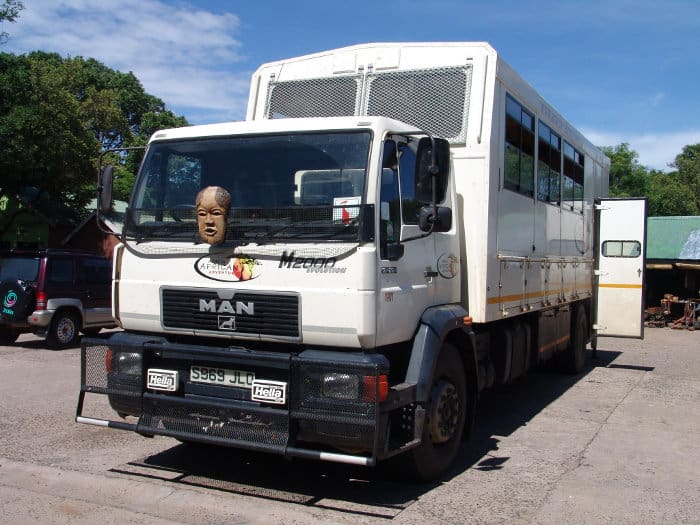
Victoria Falls is located in the heart of the Kavango-Zambezi Transfrontier Conservation Area, the second largest protected wilderness on the planet at over half a million square kilometres (it’s bigger than Spain).
Most of Southern Africa is wilderness. Botswana and Namibia are the two most sparsely populated countries in the world. You can travel for days here and not meet another tourist.
So to arrive in Livingstone is a wonderful feeling. There are restaurants, cafes, other people! There’s a place to rest and recover from the long, bumpy journeys.
Victoria Falls town and Livingstone are classic rest stops on an overland journey through Africa, whether it’s crossing the continent or doing a loop to and from South Africa. And the journey here passes through many of Africa’s best national parks and reserves.
Visa Strategy for Victoria Falls – Get the KAZA Univisa
Whatever side you choose you’ll need to cross the border in order to get the complete falls experience. Until recently that meant getting a visa for both countries, or paying for an expensive day pass.
This has changed with the implementation of the KAZA Univisa. This single visa allows you to visit both Zimbabwe and Zambia, as well as take a day trip to Botswana.
The KAZA Univisa is valid for 30 days and you can cross in and out of Zambia and Zimbabwe as many times as you like. Note that if you visit Botswana you must come back on the same day – stay overnight and you’ll need another visa.
KAZA Univisa – Everything You Need to Know
Type of Visa: Visa on arrival.
Cost: USD 50 per person.
Validity: Total of 30 days from entry.
Available When Arriving At: All Zambia’s and Zimbabwe’s international airports; Victoria Falls and Kazungula land borders (both in Zambia and Zimbabwe).
Border Crossings: Unlimited between Zambia and Zimbabwe.
Botswana Day Trips: Possible through the Kazungula border.
Eligibility: Available to passport holders from 65 countries, including all EU nations, Australia, Brazil, Canada, Japan, New Zealand, Russia, South Korea, USA.
Normal Zambia and Zimbabwe Visas
A single-entry Zambia visa costs $50. A single-entry Zimbabwe visa costs USD 55 (even more for some nationalities).
It is possible to pay USD 20 to cross Victoria Falls Bridge and visit the neighboring country for a day. However, if you leave to visit Botswana then you’ll need a double-entry visa or another USD 50 – 55.
Victoria Falls Weather & When to Go
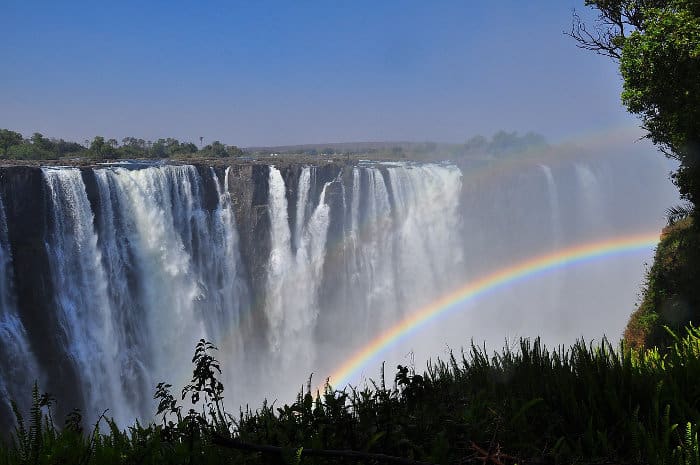
The weather is most enjoyable during the dry winter months from May to September. This time of year means coolish evenings and warm days. Think temperatures of 18 – 28ºC.
May to August is also peak flow at the falls, making it the most popular time to come. However, note that it’s more expensive and busier at this time of year.
From October to December the temperature and humidity start to rise. It’s seriously sweltering on some days and too hot to do anything in the middle of the day. It might reach 40ºC but something in the low thirties is more common.
From November the rains should start. However, this has become unpredictable in recent years and in 2018 the rains didn’t start until early December. It doesn’t rain every day but when it does rain it usually pours.
All that rain starts filling the Zambezi River. From January to March / April the rains continue as the temperature gradually decreases. December to April is low season and you’ll find the best deals at this time of year.
If you want to connect with your wild side then you should consider Victoria Falls as an all-year around destination. Don’t plan around the water or the weather – just find a time to go and do it!
Where to Stay in Victoria Falls – Zambia vs Zimbabwe

Both Livingstone and Victoria Falls are wonderful places to stay. They offer the same activities, similar experiences, and the same waterfall.
Visit either and you can get the complete experience, especially when you get a KAZA Univisa.
Whichever you choose, the best approach is to spend a whole day visiting your side of the falls. Then make a full day trip across the border, to check out both the falls and the town.
The differences between the destinations are subtle. For many travellers it may simply be a question of which is most convenient to get to, or which direction you are traveling in.
Victoria Falls Zimbabwe
The town itself is clean and lively, yet easy to get around. Staying here feels like staying in a bustling village that is surrounded by nature.
In general it’s more expensive in Zimbabwe, but you have more options of places to go and things to see.
Key Advantages of Choosing to Stay in Zimbabwe
- Most of the falls are on the Zimbabwe side.
- The falls are next to the town and you can go everywhere on foot.
- It’s more built up around the river, meaning a wider choice of places to eat and drink, but a decreased feeling of wilderness and not much wildlife running around.
- Accommodation in the town is good value and you’ll be close to everything, regardless of where you stay.
- The Zimbabwean people are wonderfully social, however there are more touts on this side.
The Downside to Staying in Victoria Falls Zimbabwe
- Food and drinks are significantly more expensive in Zimbabwe, a country that uses the US dollar.
- Zimbabwe’s river lodges can be eye-wateringly expensive.
- Unless you can afford a river lodge there won’t be as much wildlife, other than the ubiquitous baboons.
Victoria Falls Zambia
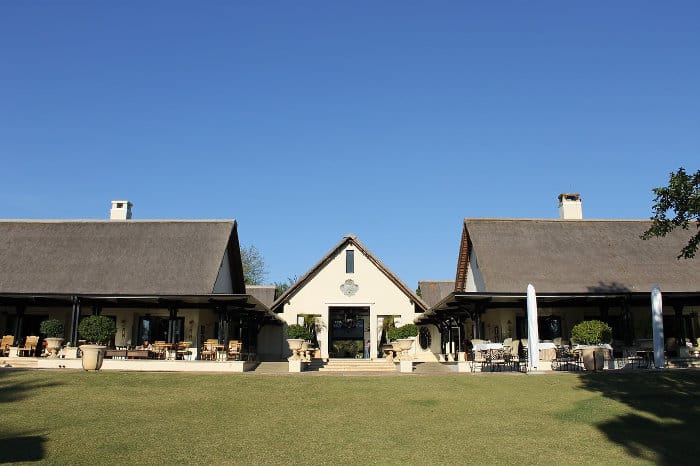
Livingstone is a dusty spread-out town eight kilometres from the falls. While pleasant enough, it doesn’t have the lively charm of its cross-border neighbour.
But…almost everything between the falls and Livingstone is a protected national park. Wildlife roams free and when you stay on the river it feels like a safari every moment of the day.
To connect with your wild side we’d highly recommend staying on the river, rather than in the town itself. Think about it: looking out onto dusty streets or looking out onto elephants?
Key Advantages of Staying in Livingstone Over Victoria Falls Town
- It’s cheaper in Zambia, for food, drinks and accommodation.
- There are lodges on the river that offer budget accommodation in a national park, surrounded by nature.
- You’re more immersed in nature on this side, with elephants, hippos and crocodiles all part of the experience.
- Livingstone is a very relaxed town and some people prefer its super laid-back vibe.
The Downside to Staying in Livingstone
- The town is eight kilometres from the falls and there’s not that much going on there.
- Victoria Falls is most impressive on the Zimbabwean side – but you’ll visit both sides right? 🙂
- There are less good choices for where to eat and drink.
Things to Do Around Victoria Falls and Livingstone
Wherever you stay there’s the same roster of activities to try. Continue reading below for a guide to seeing the actual falls.
It’s easy to spend a week here without doing or seeing everything. Realistically you need five days in order to experience the key highlights.
Botswana Chobe Day Trip

Elephants are everywhere. Trunks are swinging along the ground. Trails have been created by the pachyderms uprooting trees.
Welcome to Chobe, home to more elephants than anywhere else on the planet. Some researchers believe there are over 100,000 at the height of the dry season!
A Botswana day trip will cost USD 160 – 250 and most operators have the same itinerary, whether leaving from Zimbabwe or Zambia. This includes transport, lunch, bottled water, and activities (but no visas). Botswana is free to visit.
Set off bright and early, cross the border (use your KAZA Univisa to keep costs down), then freshen up with a coffee at one of the river lodges.
Itineraries include a Chobe River safari cruise and a game drive in the national park – one in the morning, the other in the afternoon.
From May to September there are great concentrations of elephant around the river, as well as giraffe. During other months most of the elephants are deeper in the park.
But, expect to also encounter plenty of hippos and buffalo, plus some superb birds, including vultures and fish eagles.
This article and video shows you what it’s like to cruise along the Chobe River.
Zambezi River White-Water Rafting

The world’s ultimate white-water rafting. We think so, especially after the River Nile was dammed and took most of the big rapids away from Uganda’s white-water rafting.
There’s nowhere else in the world where you can commercially raft as many grade IV+ and grade V rapids. Almost every raft flips at least once when going down so this is not for people scared of water.
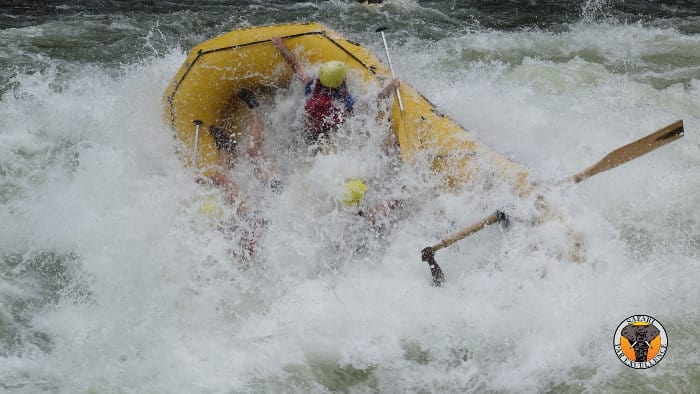
It doesn’t matter which side of the river you are staying in. Every Zimbabwe and Zambia rafting tour follows the same route on the same river – the only way is down the rapids!
Zambezi rafting is pure adrenaline from start to finish. Different rapids are bigger and scarier dependent on the water level. These photos are from Africa Freak contributor Stephen Bailey’s trip in late-November.

No experience is needed. A full-day trip costs USD 130 – 180 dependent on the season and operator. Do your research as some outfits are safer than others. Safari Par Excellence and Shearwater Whitewater Rafting have been around for the longest and are recommended.
The most exhilarating time to raft is August to December, when the river is lowest and you can tackle all 23 rapids. Usually from May to July and January to March it’s only safe to raft on rapids 11 to 23. Rafting is not possible in April and often not in May due to the high water.
Victoria Falls From Above
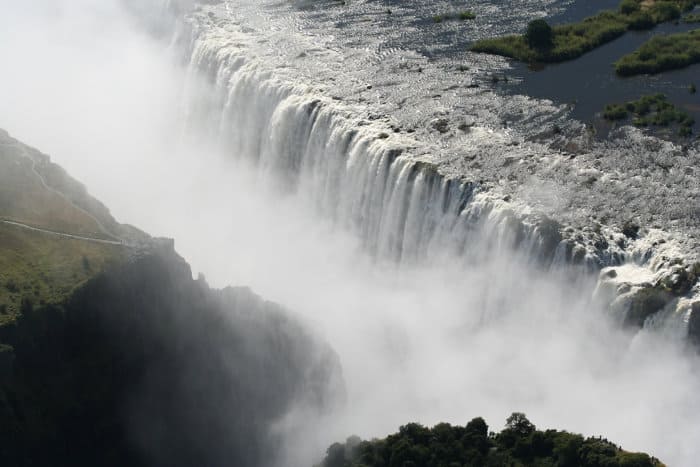
From the air you get the ultimate view: the complete falls – without getting soaked by spray.
Mosi-oa-Tunya makes sense from up here as well; the Zambezi River speckled with islands, how narrow the gorge is.
Helicopter sightseeing flights take you above the falls in just 12 minutes (around USD 150). 25-minute flights also include a chance to see wildlife in the national park, particularly elephant herds (around USD 290).
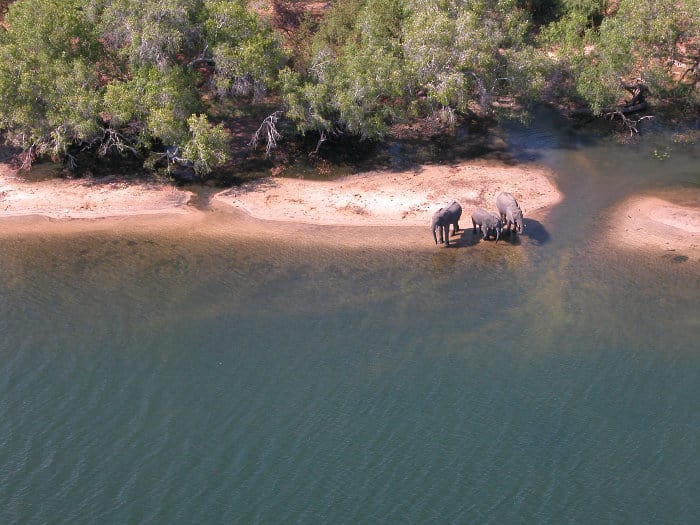
However, for the ultimate bird’s eye view try a microlight flight. It’s a similar price and you get the complete 360-degree view, just you and a guide cruising above the falls like a bird.
It’s only possible from Zambia and flights only take place in the morning. Expect to pay USD 180 for 15 minutes and $360 for 40 minutes.
This article has everything you need to know about a Victoria Falls microlight flight – as well as some dreamy photos. 🙂
Zambezi River Sunset Cruise
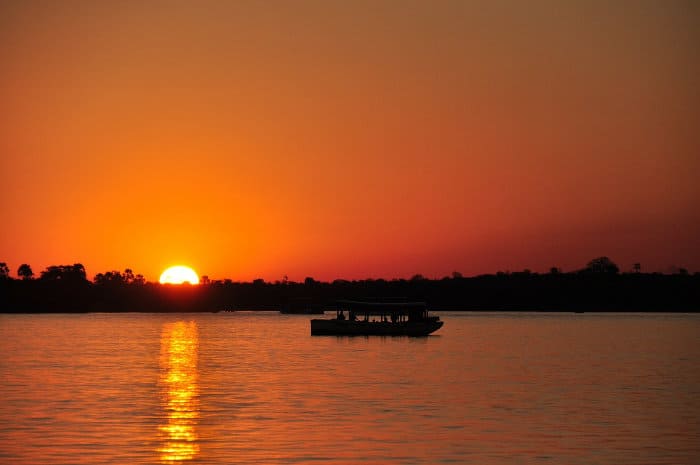
A Zambezi classic, cruising along the river at sunset as hippos emerge from their wading space. Elephants dot the banks, some of them descending into the water while using their trunks as snorkels.
Drinks are served, sometimes food as well. And the sun starts setting over the Zambezi, reds and yellows reflected in the water as animals turn to silhouetted figures.
Other than the falls themselves, a sunset cruise is the most popular activity here. Costs range from USD 40 – 90, dependent on how much food and drink are included.
Most cruises leaving from Zambia are in large boats with broad upper decks. Those from Zimbabwe tend to be in smaller craft but this isn’t an exact indication.
All boats cover the same stretch of the Zambezi, around five kilometres upriver from Victoria Falls, where a vast green island provides refuge for a wide variety of animals.
Hippos and elephants are the main attractions but you should also spot crocodiles, along with some excellent birdlife.
Canoeing on the Zambezi River

Paddling past hippos and elephants and crocodiles! Yes you can for USD 130. If you like canoeing then you should absolutely do it – but you do need some control over the canoe when dangerous animals are nearby.
Tours last half a day and set off in the morning. You’ll cruise the Upper Zambezi, on the same stretch of river as the sunset cruise. Therefore it’s not worth doing both activities.
Victoria Falls Bridge Bungee
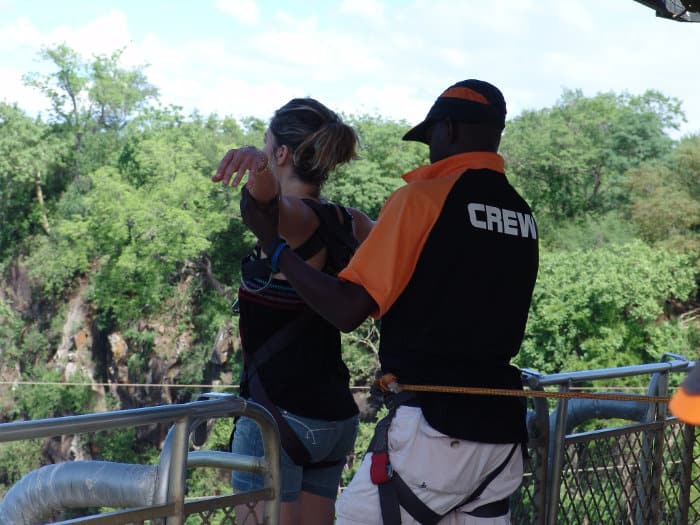
3, 2, 1, ahhhhhhh…a bungee jump off Victoria Falls Bridge in the no-man’s land between Zambia and Zimbabwe.
Of course it’s scary – isn’t that the idea of a bungee jump? But it’s more beautiful than most. During peak flow jumpers descend through rainbows in the mist.
Although not the world’s highest – it’s only a spine-chilling 111 metres! – it’s one of the most iconic jumps and very popular with people who have never jumped before.
If you don’t want to dive forward there’s also a bungee swing from the same ledge. Just step out and fall feet first, then swing out into the gorge – which is easy to say and hard to actually do!
Here’s the catch. The Victoria Falls Bridge bungee is expensive. It currently costs USD 160 for either the bridge swing or bungee jump. That’s a lot of money for a few seconds of thrill. Luckily you don’t need any visa for going on the bridge – just show your passport and return the same way (you won’t get any stamps).
It’s better value to go for the Big Air Experience. For USD 210 you get the bungee jump, bungee swing, and a bonus zip line taking you to the bridge.
Walking With Rhinos in Mosi-oa-Tunya National Park
Mosi-oa-Tunya National Park is far from the best place in Africa to go on safari. Cute and compact, the park provides a nice enough experience but doesn’t have the wow of places nearby (such as Chobe).
But there is one thing here…rhinos. The only rhinos in Zambia to be precise. And some Mosi-oa-Tunya safaris allow you to walk with these giants.
Without the rhino walk it’s not worth paying for a safari here. Save your money for other parks.
But…step, step, step…you creep closer to the rhinos, staying downwind of them while accompanied by armed rangers.
Usually you see at least half a dozen rhinos in the bush, almost always during the middle of the day when they are resting (you don’t want to encounter a lively rhino!).
It’s a thrilling experience, coming to within ten metres of one of the world’s most endangered mammals. Just to watch them snoozing from so close provides a wild connection you will never forget.
Rhino walks cost around USD 110 – 130 for a half-day experience. Note that if you do multiple activities in Mosi-oa-Tunya National Park on the same day you will save USD 10 on the park fees.
Devil’s Pool
The most iconic Victoria Falls experience is to go swimming in Devil’s Pool, on the very lip of the cascades.
It’s very famous. There’s a small pool that’s protected from currents, enabling you to literally be on the edge of the falls, looking down the veil of water.
At Africa Freak we’re not 100% sure about Devil’s Pool. Yes, it’s a wonderful connection with nature and there’s no better way to appreciate the power and growling roar of water.
However, two guides have died here in the last ten years and the activity is not without some personal risk.
The guides died trying to rescue tourists who were being pushed away from the safe slither of water. It is certainly wild here and Devil’s Pool serves to remind us that the world’s most powerful waterfall is not something to be taken lightly.
Things to Do in Victoria Falls Town
There’s a lively buzz around Victoria Falls Town, partially created by visitors returning from their daily activities. Whatever you do here, you end up with a smile on your face.
You’ll find lots of boutique shops and curio stores, all of them selling much of the same thing – first-time visitors to Africa will be delighted, other visitors will have seen most of it elsewhere.
A couple of local bars pump out Zimbabwean music while serving traditional barbecue dishes.
On the road to the falls, where the road meets the railway, turn left to find The Three Monkeys Restaurant & Bar, plus the craft River Brewing Company. These are lovely places to hangout with a drink.
Things to Do in Livingstone
Livingstone has three decent museums. The Livingstone Museum has good exhibits on the explorer himself; Railway Museum gives a sense of colonial times while the Gateway Jewish Museum tells a mostly untold story.
You’ll also find a bustling local market, where people haggle over vegetables and clothes, the goods often overflowing stalls onto dusty ground.
While Victoria Falls provides a half-Western half-Zimbabwean vibe, drinking in Livingstone is a local affair – it’s a lot of fun if you haven’t had a night out in Africa before.
The town is big and spaced out. The attractions can keep you entertained for half a day but not that much longer. Elephants and hippos and baboons are always entertaining which is why it’s good to stay on the river, with nature.
Visiting Mosi-oa-Tunya (Victoria Falls)

The two sides of the falls are in two different countries and there is no simple walkway between them.
So we’ll state it again. Take your time. Spend a day on one side, then take a day trip and enjoy the falls from the other side. It’s worth the money if you have a KAZA Univisa.
You absolutely do NOT need a guide to visit Victoria Falls. All the pathways are well marked and there are maps that show you where to go. Given how much guides want to charge here it’s an unnecessary use of money.
Visiting Victoria Falls Zambia

Getting In & Cost
Mosi-oa-Tunya National Park is in Zambia and the entrance ticket costs USD 30. Most lodges and hotels offer free transfers to the falls; a taxi from town or a river lodge should cost 80 – 100 Zambian Kwacha (USD 6 – 8).
Get your ticket at the first entrance gate, walk past seemingly hundreds of curio stalls that all sell the same thing, and show your ticket at a small gate on your left.
Seeing The Falls
Upon entering the trail splits. Head right to the banks of the Zambezi River. If it’s low water you can walk across the riverbed. When it’s high water you’ll be met by a resounding surge of water.
Return to the main trail and follow it through a short section of forest. It’s here you’ll see Victoria Falls for the first time, specifically The Eastern Cataract.
At mid and peak water times this is the best view you will get. From here you cross Knife-Edge Bridge. When water is high it gets very wet and slippy here with all the spray coming down – you might even walk through a 360-degree rainbow.

Across the bridge you’ll stand on a cataract in the middle of the river. There’s a short loop that provides a stunning view of Rainbow Falls and Horseshoe Falls, as well as the distant mist coming up from the Main Falls.
Note that when water is low you won’t see much water anywhere on the Zambian side. However, it’s very impressive to view the black basalt rock.
Bonus Trek
Return towards the park gate and there’s another trek to do. Follow some steep steps signposted to the Boiling Pot.
Watch out for baboons. Great troops of them guard the trail and they attack anyone who is openly carrying food (keep it in a closed backpack). Also watch out with your camera – get too close and the baboons will snarl back.
It’s a 20-minute walk down to the Lower Zambezi River, where you’ll be looking up at Victoria Falls Bridge as mist sails across from the falls. If ever there was a place for a picnic it’s here, especially because the baboons don’t come this close to the water’s edge.
Visiting Victoria Falls Zimbabwe
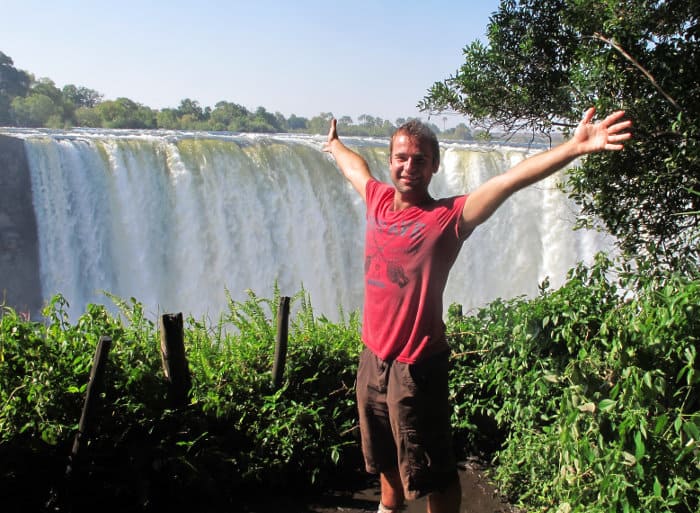
Getting In & Cost
It’s worth walking to the falls when you’re staying in Zimbabwe. A taxi from the town will cost USD 5 – 10 dependent on your negotiation skills. The road goes downhill, across the railway, then curls to the left.
Turn off the road after the railway, when you see a path on the right. Take this route as it is nicer than the road, plus it can take you to a lovely cafe on the river. When the path ends it reaches a small curio market – across the road is the park entrance.
Victoria Falls National Park costs USD 30 for international visitors. Note that the two parks are completely separate so you need two entrance tickets (2 x USD 30) to visit both.
Seeing The Falls
Upon entering there is an excellent exhibit that details the geology and history of Mosi-oa-Tunya, as well as comparing the falls with others around the world.
It’s highly educational and makes you wonder why they don’t have something similar on the Zambian side. Most people go first to the falls then stop at the exhibit on the way out.
Trails head out in different directions from here. It’s recommend to follow the sign for Livingstone Statue and Devil’s Cataract first, so you do the dry parts of the trail first.
Just before Devil’s Cataract the trail splits to the right. Then it runs parallel to 75% of Victoria Falls. There are 15 different viewpoints along the way, some of them hidden by thick, green forest.
Viewpoints from 1 – 12 show Devil’s Cataract and the Main Falls. Although there’s a lot of spray there’s also a lot of tree cover, so you can mostly stay dry.
The second half of the trail has no fences. It takes you alongside Horseshoe Falls and Rainbow Falls and there is no tree cover. During most months of the year you will get soaked by the spray.
Don’t be tempted to go off the trail. The rocks are slippy and it’s a long long way down, plus the trail is just five metres from the edge. The trails end at Danger Point, where you can see the Eastern Cataracts in all their glory.
Victoria Falls – Your Experiences
Anything else you need to know about Victoria Falls? Travel here and you’ll really connect with your wild side.
Here’s your chance to stay amid some of Africa’s most dramatic nature, while still enjoying plenty of creature comforts.
Enjoy! 🙂
